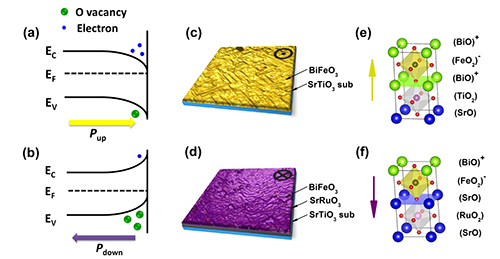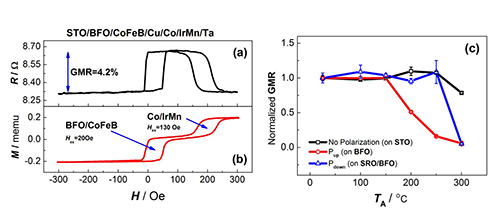Polarization-Mediated Thermal Stability of Metal/Oxide Heterointerface
Date:30-10-2015 Print
Heterointerface comprising ferromagnetic metals and ferroelectric/multiferroic oxides is a probable candidate in the quest for the next-generation magnetoelectric memories, in which magnetism can be tuned electrically via strain-/spin-mediated couplings across the interfaces. For spintronics devices, such as magnetic tunneling junctions (MTJs), annealing process is usually indispensible. However, ferromagnetic metals and ferroelectric/multiferroic oxides are chemically incompatible with each other as oxidation of the metal layer is apt to take place during the annealing process. The thermal stability of the metal/oxide interface is at the core of the reliability of the interface-mediated magnetoelectric effect, which should warrant adequate attention in the recent magnetoelectric renaissance. Hence it remains a challenge to improve the stability of the metal/oxide heterointerface before it can be incorporated with existing spintronics devices to build the new class of magnetoelectric random access memories (ME-RAM).
In this communication, we report an unexpected modulation of thermal stability of metal/oxide interface by the spontaneous polarization of the ferroelectric oxide. The mechanism behind the polarization-mediated thermal stability is believed to rest on the inherent coupling between spontaneous polarization and defect chemistry of the ferroelectric oxide via electrostatic interaction. This polarization engineering improves thermal stability of the interface between BFO and giant magnetoresistance (GMR) multilayers by 100℃. This finding casts new insights into the chemistry of the metal/oxide heterointerface, and provides extra degree of principle in device design with better performance.
This study entitled “Polarization-Mediated Thermal Stability of Metal/Oxide Heterointerface” was published on Advanced Materials.
The project was supported by the State Key Project of Fundamental Research and 863 Plan Project of Ministry of Science and Technology and National Natural Science Foundation of China.
 |
| Fig.1 Schematic band diagrams, polarization, and atomic stacking of ferroelectric oxide (BFO) layer. (Image by Institute of Physics) |
 |
| Fig.2 a) Giant magnetoresistance curve and b) representative magnetic hysteresis loop of STO/BFO/CoFeB(4)/Cu(2)/Co(4)/Ir22Mn78(12)/Ta(5 nm) after 150 ℃ annealing. c) Annealing temperature (TA) dependence of normalized giant magnetoresistance ratio. (Image by Institute of Physics) |
Contact:
Institute of Physics
Han Xiufeng
Email:xfhan@iphy.ac.cn
Key word:
Spintronics, Polarization-mediated, Multiferroic, Thermal Stability;
Abstract:
The thermal stability of GMR devices on ferroelectric BFO films was investigated. It is observed that the BFO polarization direction induced oxygen vacancies difference is the key to the change in thermal stability of the metal/oxide heterointerface. Through polarization engineering, the thermal stability of the interface between BFO and CoFeB can be improved by about 100℃. The oxidation at the interface between BFO and GMR multilayers is confirmed by combining STEM and EELS with macroscopic magnetic characterizations. This work could be helpful to introduce annealing process to BFO/FM interface while maintain the magnetic properties of ferromagnetic layer, and the development of electrically tunable GMR or TMR devices for memory applications.

